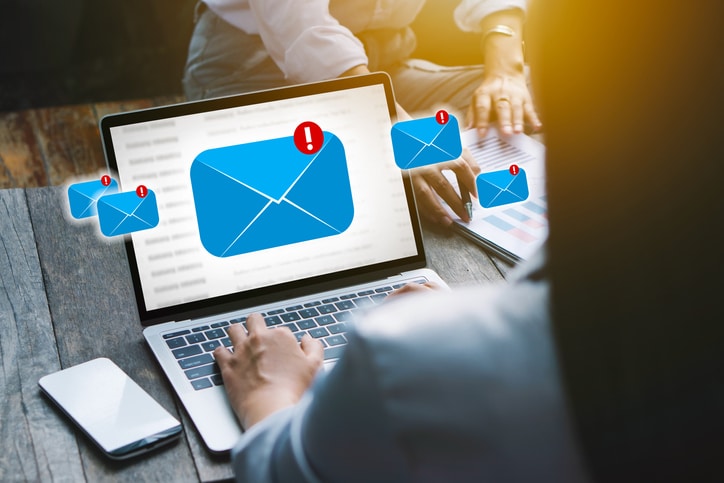Even in 2022, email marketing is still one of the best-performing digital channels ever created, boasting a ROI of $42 for every $1 spent. Facebook currently has 2.9bn active users, but nearly four billion users have at least one active email account.
And yet, despite this pool of opportunity, thousands of marketers still struggle to achieve meaningful ROI from email.
The reason why is simple.
As a consumer, you open your inbox on any given day and you’re likely to be greeted by a flood of promotional emails sent by everyone from your dentist to your dog walker — too many emails, too much clutter, too much noise.
In this article, we’re going to help you cut through inbox clutter. Read on as we divulge the top 5 challenges email marketers face in 2022, along with the tactics you can use to solve them if and when they arise.
Top 5 Email Marketing Challenges Every Marketer Faces (and How You Can Solve Them)
1. Boosting Engagement Rates
You wouldn’t invite a complete stranger to dinner and a kung fu movie, would you? Probably not, for a number of reasons:
- You have no rapport with that person
- You have no idea whether they like kung fu movies
- It’s creepy
And yet if you scroll through your inbox, you’ll find countless examples of brands that are guilty of blanket emails sent out to their entire database offering products and services that their recipients have zero interest in.
This inevitably results in lower engagement, which equals lower sales, and in turn, lower email ROI.
The solution: Segment your audience.
Your audience are individuals with unique desires, needs, and interests. So, if you want to keep engagement high, you need to first segment your audience based on their engagement, intent and purchase behavior.
Consider breaking your audience down into the following segments as a starting point:
- Purchase status: are they a new subscriber or customer?
- Customer Lifetime Value (CLTV): are they a single-sale or a repeat customer?
- Product affinity: when they buy, which categories do they tend to shop in?
By breaking your email lists into segments based on key customer attributes, you make your life as an email marketer infinitely easier. Why? Because segmentation is the first step towards personalization.
With defined segments, you can target your subscribers with personalized content that’s relevant to their interests. The result? More engagement, more trust, and more sales.
2. Increasing Customer Retention
With email marketing, it’s all about converting subscribers into first-time customers, and turning first-time customers into loyal, repeat customers.
However, that’s easier said than done.
The demise of the third-party tracking cookie hit marketers hard, and acquiring new customers has never been more expensive. As a result, there’s no better time to focus on retaining your current customers.
In the face of compelling offers, discounts, and seemingly endless sales, how can you keep your customers opening your emails, fend off churn, and persuade your customers to stick with your brand?
The solution: Personalized and interactive content.
Setting up list segmentation is a step in the right direction, but it’s time to take things one step further.
By rewarding your customers with personalized e-commerce email content that’s tailored to their specific interests and on-site behavior, you’ll grab their attention with compelling, highly relevant content that gives them a reason to keep opening your emails, and most importantly, continue shopping with your brand.
Some effective ways to personalize emails include:
- Geolocation: Send customers special offers exclusive to nearby stores
- Weather: Is a heatwave about to hit a certain region? Send customers offers for specific products that can help them stay cool
- Visual affinity: Advanced customer engagement platforms can use AI to identify patterns in the items customers frequently view and purchase, and recommend products based on that
3. Improving Email Personalization
Personalized content might be the key to customer retention, but creating personalized content that actually resonates with your subscribers, rekindles lost engagement, and drives sales is a fine art.
The big question most marketers struggle with is: how do you get the information you need to make the right decisions about your personalization strategy?
The solution: Leveraging user data.
From clicks to add-to-carts and conversions, your audience is telling you what they like — and what they don’t. As an email marketer, that insight is pure gold.
By connecting your email marketing software to your online store, you’ll unlock a wealth of purchase history and online activity that you can use to identify innovative opportunities for email content personalization.
Notice a customer browsing a particular category but not buying? Create a personalized discount code to entice them to convert.
Trying to tempt a loyal customer to explore your other product ranges? Create an email automation to cross-sell them to related products that they could be interested in.
The options for email personalization are limitless, and a well-written, personalized email works wonders for engagement, retention, and driving repeat purchase.
See what Emarsys’s industry-leading deliverability and real-time AI-powered personalization can do for your 1:1 email marketing.
4. Integrating Your Data
From fueling 1:1 personalization to accurately tracking results, data is the backbone of any successful email marketing campaign. However, when it’s stored across a multitude of disconnected platforms, integrating product, sales, and customer data into a single source of truth so you can attain a single view of your customer poses a real challenge.
The solution: Data-integration tools.
Manually integrating data can be a time-consuming process even for small brands, and there’s no reason you have to handle the heavy lifting yourself.
Data integration tools are designed to help you quickly and easily unify your customer, sales, and product data. Your goal should be to create a holistic view of each customer, giving you the clear picture you need to deliver the right content to the right person at the right time.
Your data integration tool should be able to:
- Unify historical and real-time data
- Cleanse your data and remove duplicates
- Enrich your data with AI to enable predictive analytics
- Report on which campaigns and channels are delivering ROI
Pick a tool that ticks the above boxes, and you’ll be well on your way to fully integrated data and true customer-first marketing.
5. Improving Email Deliverability
Creating relevant, personalized email copy is no good if it never reaches your audience’s inbox. And if you’re struggling to identify the leaks in your email marketing strategy, deliverability could be costing you money before your emails even have a chance to perform.
Email deliverability is determined by:
- Subject line wording: Avoid spam words and phrases
- Subject line length: Keep subject lines to 35 characters max
- Multi-part message: Ensure there is a text and html version of your email to avoid triggering spam filters
- Message size: 15-100kb is the sweet spot to stop messages being truncated
- Link domain consistency: Ensure you use the same domain for links and sender
- Phishing links: Make sure all links in your message are secure
- Image URLs: Make sure individual image URLs are valid
- Alternate text for images: Deliverability is improved if you have text descriptions for images
- Responsiveness: Are your emails mobile-friendly?
- Image domain consistency: If your images have a different domain to your sender domain, this will be treated as suspicious
Whenever you send an email, you’re either building (or damaging) your domain’s reputation. Some level of spam ratings are to be expected with email marketing, especially if you’re sending at higher volumes. However, too many and you’ll be doing damage that can be difficult to repair.
So, if you’re playing fast and loose with the content of your emails — or sending them to people who really don’t want to hear from you — you’ll quickly dismantle any domain reputation you’ve accrued.
The solution: Look into your subscription process and run deliverability checks.
To protect your hard-earned domain reputation and increase your email deliverability, you need to carefully consider what content you’re sending, and to whom you’re sending it.
Review your subscription process and make sure you’re only marketing to people who have explicitly opted-in through a sign-up form or similar source. Additionally, on those sign-up forms, be clear on what content your new subscriber should expect to receive to avoid any unwanted surprises.
Lastly, ensure that your customer engagement platform has the capability to run deliverability checks that will flag if your message contravenes any of the points listed above.
Overcome Your Email Marketing Challenges with an AI-powered Customer Engagement Platform
Creating and delivering high-performing, personalized emails can be a challenging process, but follow the solutions laid out in this post and you’ll be ready to tackle email marketing’s greatest challenges head-on.
Fortunately, we’ve taken into account all these challenges, and created an all-in-one solution to give you back your power as an email marketer.
The Emarsys omnichannel customer engagement platform comes complete with AI-powered email marketing that combines industry-leading deliverability with AI-powered personalization. The result? High-impact email campaigns that convert subscribers to buyers and drive repeat sales.
Go from basic batch-and-blast sending to relevant, personalized 1:1 email marketing that increases CLTV and revenue.











